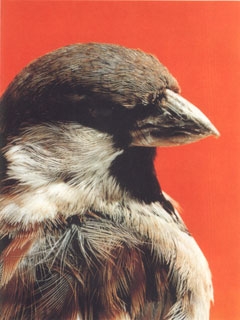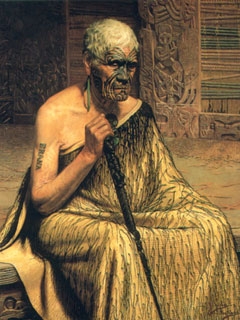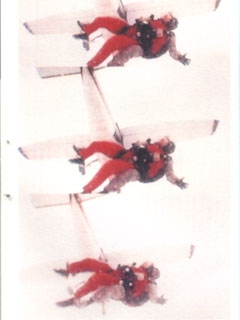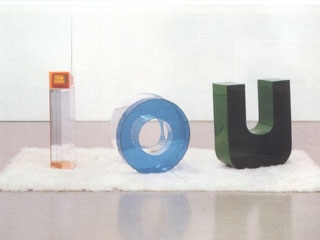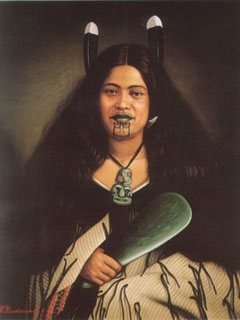Feature: Reviews
Multistylus Programme: Recent Chartwell Acquisitions
- Auckland Art Gallery/Toi o Tamaki
- New Zealand/Aotearoa
- 16 June - 16 August 2001
A way in down under
When you enter a new country, everything — place, people, and their history — comes under your personal microscope. Trying to make sense of all this new information, I considered how I could integrate my new experiences in meaningful ways. As an artist, writer and educator, I naturally sought out art to aid in my quest. For me (as for many), art can help illuminate how the culture of a place and a people was, and continues to be, constructed.
I arrived in Auckland, New Zealand early one morning to begin an artists’ residency program, and was initially struck by the politeness of my shuttle driver and the fact that he was wearing a tie (something not normally seen in U.S. shuttle drivers). On his recommendation, I found a fantastic place to stay — the old residence of the queen of Tonga which has been transformed into a beautiful "backpackers" (as NZ’s hostels are known) in the tony Parnell neighborhood. Tired and wired by plane travel, I wanted to walk around and explore the city and its occupants. I made my way by foot downtown, passing ladies who lunch in chi-chi Parnell and a park where students in baggy clothes paraded. I soon found myself at the Auckland Art Gallery.
The first permanent gallery in New Zealand, the Auckland Art Gallery was built in 1888 as part of the Free Public Library and contains the largest and most comprehensive collection of ndigenous and international art in the country. The Gallery offered a way into New Zealand culture by not only introducing me to the historically rich permanent collection but also to a recent offering from the Chartwell Collection. The Chartwell Collection was established in 1974 by founding trustee Rob Gardiner to focus on the changing nature of art and art practice in contemporary Australian and New Zealand art. The Collection, always intended for public use, currently comprised of more than 650 works of varying media. Although the Auckland Art Gallery has an annex across the street built in 1995 that usually houses contemporary work, this exhibition was held in the main building with the permanent collection.
Introducing new work from New Zealand and Australian contemporary artists to the public is a main goal of the Collection. According to Auckland Art Gallery Director Chris Saines, “It (the Chartwell Collection) is about making them (contemporary artworks) work as part of a belief that contemporary art can fundamentally change how we think about and understand our place in the world.” Multistylus Programme is the fourth annual exhibition of recent additions since the Collection moved from the Waikato Museum of Art and History in Hamilton (nearest largish town to Auckland) on extended loan to the Auckland Art Gallery in 1997. There is no particular curatorial overlay per se in this group exhibition which showcases work from both established and emerging artists added to the Collection in the last year or so. However, this mixed bag survey of recent creations offered me an opportunity to check out current themes and issues being addressed by contemporary NZ and Australian artists and to see them in relation to historical NZ works of art from the permanent collection.
The exhibition title, Multistylus Programme, was appropriately appropriated from a double turntable piece by up-and-coming Australian artist Ricky Swallow (one of the few artists here with an international reputation and whose work I was familiar with). Like a multistylus, the exhibition contains a variety of media and messages. The luminescent lightboxes of Jim Spears and John Nixon’s enamel and wood constructions painted black, white and mostly orange evoke abstract signage in a heraldic display. Also using light is Bill Culbert. His Plain of Jars (1996), constructed of lightbulbs in jars, creates a glowing memorial to the Laotian battlefield so named for the jars discovered there in the 19th century.
The creepy and gothic is a popular thread in New Zealand artistic production. Michael Parekowhai’s large-scale color photo Elmer Keith (2000), for example, presents a sparrow that becomes predatory because of its blown-up scale; Psycho (1999), by Ronnie van Hout, sets a disturbing black and white video of a shadowy figure gripping a knife inside a commercial model of the house from the movie Psycho.
Background and history will, of course, affect how one “sees” and I couldn’t help but see parallels here with current California artists and movements. In Systematic, Towards the Theory if Everything, (1999), Patrick Pound invoked the potent collaged blackboards of Raymond Saunders. In Closer-Mercer, (2001), and Great Expectations (2001), photographs and a video documenting a jump from a plane, Yuk King Tan joins any number of young conceptual daredevils. (This piece also speaks to New Zealand’s thirst for high-risk adventure sports.) And, in I.O.U., (1998), Mikala Dwyer imbues a 70s-era pop lounge with the promise of some kind of fulfillment, reminiscent of the work of a number of young artists throughout California, (especially Los Angeles) whose work is backgrounded by the myth(s) of Hollywood.
Seeing the Chartwell Collections’ modern works in this old-fashioned columnar gallery room allowed me to link these contemporary pieces with older works from the established Auckland Art Gallery collection — works that I was also seeing for the first time. Works that I found particularly arresting included Gottfried Lindauer’s and Charles Frederick Goldie’s portraits of Maori men and women from the late 19th and early 20th centuries, as well as early drawings of the New Zealand landscape and its inhabitants. The portraits show a range of portrayals of the Maori: Lindauer illustrated proud and vital leaders while Goldie represented people with an essential sadness, as he believed the Maori were a dying race.
Representing diverse aspects of Maori culture is a common theme in New Zealand art, although now it is more likely for Maori artists to represent their range of interests and possibilities themselves, seen here in Multistylus Programme as well as in Kei Whea @ ("where it’s at") [where it’s at being the translation of the Maori Kei Whea) at the Sarjeant Gallery in Wanganui (www.sarjeant.org.nz) and Techno Maori: Maori Art in the Digital Age at the City Gallery in Wellington (www.city-gallery.org.nz).
Interestingly, in a complicated turnaround, (and based on my limited experience as a newcomer to NZ), I haven’t come across any contemporary European New Zealand visual artists who directly address the complex issues surrounding interactions between the Europeans and Maoris, past and present. While it is about time that Maori artists represent themselves in a gallery setting, it is a shame that this rich topic seems almost off-limits to non-Maori artists. It could be seen as another form of marginalization, one that is — this time — perhaps self-imposed.
Alongside an exploration of representations of the Maori past in the Historical New Zealand Art from the permanent collection and present representations of and by Maori in the challenging Chartwell exhibition, global art world themes such as dislocation, yearning and memory also surfaced, creating a rich mix that appears to be very much what contemporary NZ culture is about. As expected, the Auckland Art Gallery furnished me with a foothold into New Zealand’s culture, the complexities of which I look forward to continuing to uncover.
Multistylus Programme: Recent Chartwell Acquisitions was on view at the Auckland Art Gallery, corner of Wellesley and Kitchener Streets, Auckland, New Zealand.
For more information, call (64) 9 307 7700 or visit www.akcity.govt.nz/artgallery

